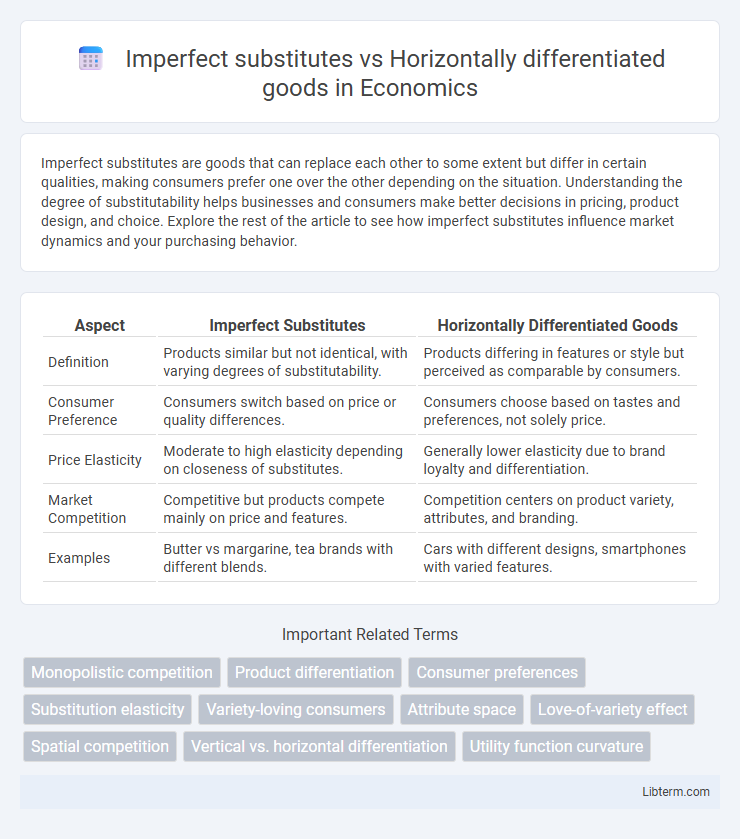Imperfect substitutes are goods that can replace each other to some extent but differ in certain qualities, making consumers prefer one over the other depending on the situation. Understanding the degree of substitutability helps businesses and consumers make better decisions in pricing, product design, and choice. Explore the rest of the article to see how imperfect substitutes influence market dynamics and your purchasing behavior.
Table of Comparison
| Aspect | Imperfect Substitutes | Horizontally Differentiated Goods |
|---|---|---|
| Definition | Products similar but not identical, with varying degrees of substitutability. | Products differing in features or style but perceived as comparable by consumers. |
| Consumer Preference | Consumers switch based on price or quality differences. | Consumers choose based on tastes and preferences, not solely price. |
| Price Elasticity | Moderate to high elasticity depending on closeness of substitutes. | Generally lower elasticity due to brand loyalty and differentiation. |
| Market Competition | Competitive but products compete mainly on price and features. | Competition centers on product variety, attributes, and branding. |
| Examples | Butter vs margarine, tea brands with different blends. | Cars with different designs, smartphones with varied features. |
Understanding Imperfect Substitutes
Imperfect substitutes are products that fulfill similar needs but differ in attributes, quality, or brand perception, leading consumers to exhibit varied preferences and willingness to pay. In contrast, horizontally differentiated goods vary primarily in features or style without significant differences in quality, causing consumer choice to depend on taste rather than utility differences. Understanding imperfect substitutes involves analyzing how price changes and product differentiation influence demand elasticity and market competition dynamics.
What Are Horizontally Differentiated Goods?
Horizontally differentiated goods are products that serve the same basic function but differ in attributes such as style, brand, or features, appealing to consumer preferences at the same quality and price level. In contrast to imperfect substitutes, which vary in quality or price, horizontally differentiated goods offer alternative choices without clear superiority among options. This differentiation influences market competition by fostering product variety and consumer choice within the same product category.
Key Differences Between Imperfect Substitutability and Horizontal Differentiation
Imperfect substitutes are products that serve similar functions but differ in attributes, leading to partial consumer interchangeability, while horizontally differentiated goods are variations within the same category that appeal to consumers' diverse preferences without quality hierarchy. Key differences include the degree of substitutability, where imperfect substitutes exhibit partial cross-price elasticity, and horizontal differentiation reflects niche targeting based on taste or style rather than utility differences. Market competition dynamics also vary, as imperfect substitutes face competition influenced by price and feature trade-offs, whereas horizontally differentiated products compete primarily on consumer preference and variety.
Consumer Preferences and Choice
Consumer preferences for imperfect substitutes reflect a willingness to switch between similar products based on factors like price, quality, and availability, whereas horizontally differentiated goods appeal to diverse tastes and attributes, such as flavor or brand style, leading to varied consumer choices. Imperfect substitutes create competition mainly through price sensitivity, while horizontal differentiation allows firms to target niche markets by emphasizing unique product features. This distinction shapes market demand elasticity, influencing how consumers balance trade-offs between product similarity and differentiation in their purchasing decisions.
Price Competition in Imperfect Substitutes vs. Horizontal Differentiation
Price competition in imperfect substitutes often results in less aggressive pricing strategies due to the distinct but related nature of products, allowing firms to maintain higher prices without losing all customers. In horizontally differentiated goods, firms compete by targeting different consumer preferences, which reduces direct price wars and enables diverse pricing strategies based on perceived quality or features. The degree of substitutability and product differentiation fundamentally influences firms' pricing power and market equilibrium outcomes in both scenarios.
Market Structure Implications
Imperfect substitutes create a market structure characterized by monopolistic competition, where firms possess some market power due to product differentiation but face competition from close alternatives. Horizontally differentiated goods intensify this dynamic by offering variations in attributes that appeal to diverse consumer preferences, leading to segmented demand within the same market. This segmentation fosters strategic pricing behavior as firms balance between capturing niche markets and deterring entry, influencing market equilibrium and competitive intensity.
Examples of Imperfect Substitutes
Imperfect substitutes are products that satisfy similar consumer needs but differ in quality, features, or branding, such as different smartphone brands like Apple and Samsung. Horizontally differentiated goods represent variations in consumer preferences without a quality hierarchy, exemplified by soda flavors from the same brand. These distinctions highlight how imperfect substitutes involve preference for varied attributes, whereas horizontal differentiation centers on taste or style preferences.
Examples of Horizontally Differentiated Goods
Examples of horizontally differentiated goods include branded smartphones like Apple iPhones and Samsung Galaxy models, which offer different features and designs targeting diverse consumer preferences without a clear quality hierarchy. Other instances are soft drink brands such as Coca-Cola and Pepsi, where product variations cater to taste rather than quality differences, making them imperfect substitutes. This differentiation emphasizes variety and consumer choice within the same product category.
Impacts on Product Positioning and Branding
Imperfect substitutes and horizontally differentiated goods both influence product positioning by emphasizing unique features that cater to specific consumer preferences, which strengthens brand identity and market segmentation. Firms leverage subtle differences in attributes such as design, quality, or functionality to create perceived value, allowing brands to command pricing power despite close substitutability. This strategic differentiation enhances customer loyalty and reduces direct price competition within crowded markets.
Policy and Economic Welfare Considerations
Imperfect substitutes and horizontally differentiated goods influence policy design by shaping market power and consumer choice, requiring regulators to balance competition with product variety. Economic welfare improves when policies mitigate monopolistic tendencies in imperfect substitutes markets while preserving diversity seen in horizontally differentiated goods. Effective interventions, such as antitrust regulations and consumer protection laws, enhance allocative efficiency and consumer surplus in these differentiated product markets.
Imperfect substitutes Infographic

 libterm.com
libterm.com